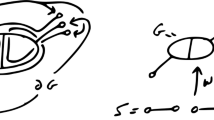Abstract
For every integere≧3 there exists a non-free torsion-free profinite group containing ª as an open subgroup.
Similar content being viewed by others
References
E. Binz, J. Neukirch and G. H. Wenzel,A subgroup theorem for free products of profinite groups. J. Algebra19 (1971), 104–109.
M. Jarden,Algebraic extensions of finite corank of Hilbertian fields, Isr. J. Math.18 (1974), 279–307.
M. Jarden,Torsion-free profinite groups with open free subgroups, Arch. Math.39 (1982), 496–500.
O. V. Mel'nikov,Normal subgroups of free profinite groups, Math. USSR Izv.12 (1978), 1–20.
J.-P. Serre,Sur la dimension cohomologique des groupes profinis, Topology3 (1965), 413–420.
J. R. Stalling,On torsion-free groups with infinitely many ends, Ann. Math.88 (1968), 312–334.
R. G. Swan,Groups of cohomological dimension one, J. Algebra12 (1969), 585–610.
Author information
Authors and Affiliations
Additional information
Supported by Rothschild Fellowship.
Rights and permissions
About this article
Cite this article
Haran, D. Non-free torsion-free profinite groups with open free subgroups. Israel J. Math. 50, 350–352 (1985). https://doi.org/10.1007/BF02759765
Received:
Revised:
Issue Date:
DOI: https://doi.org/10.1007/BF02759765



